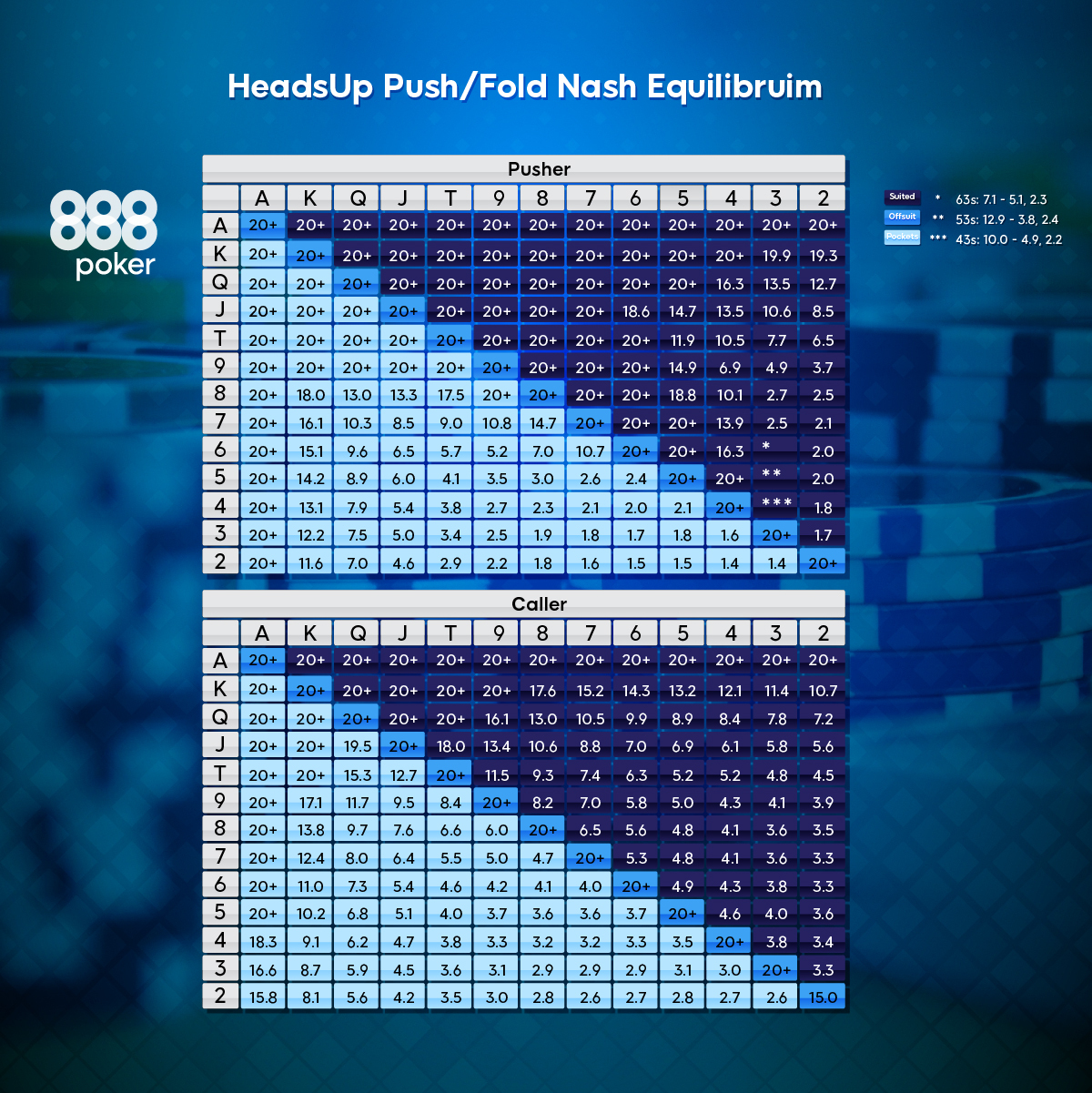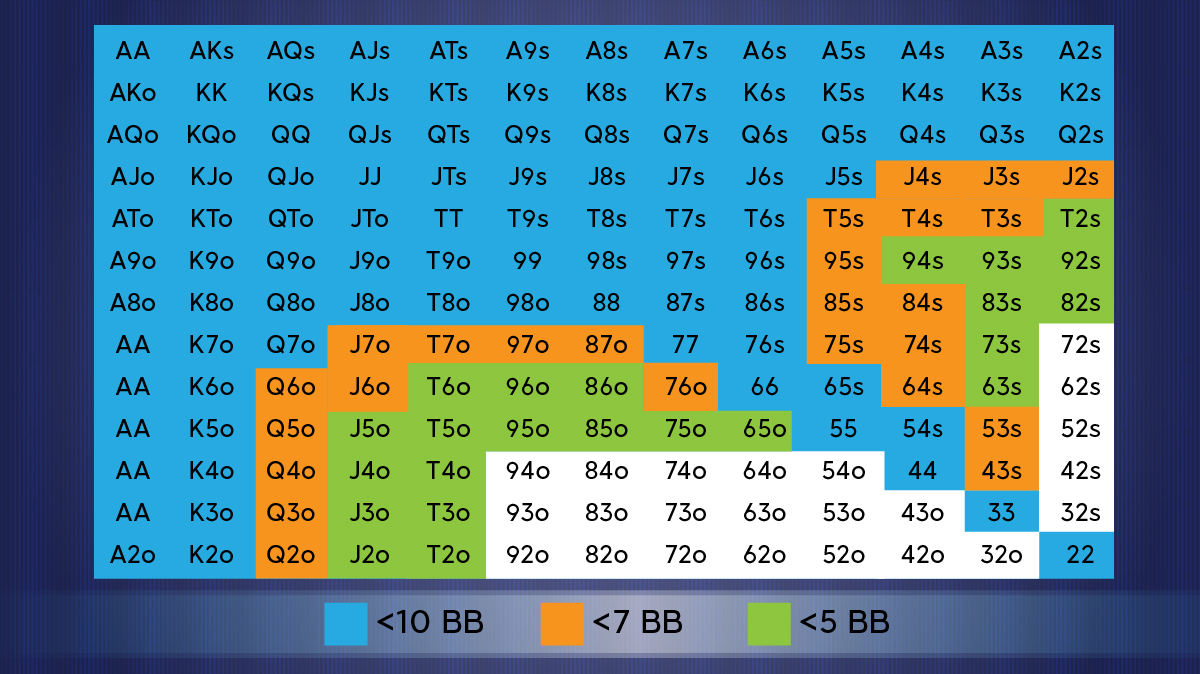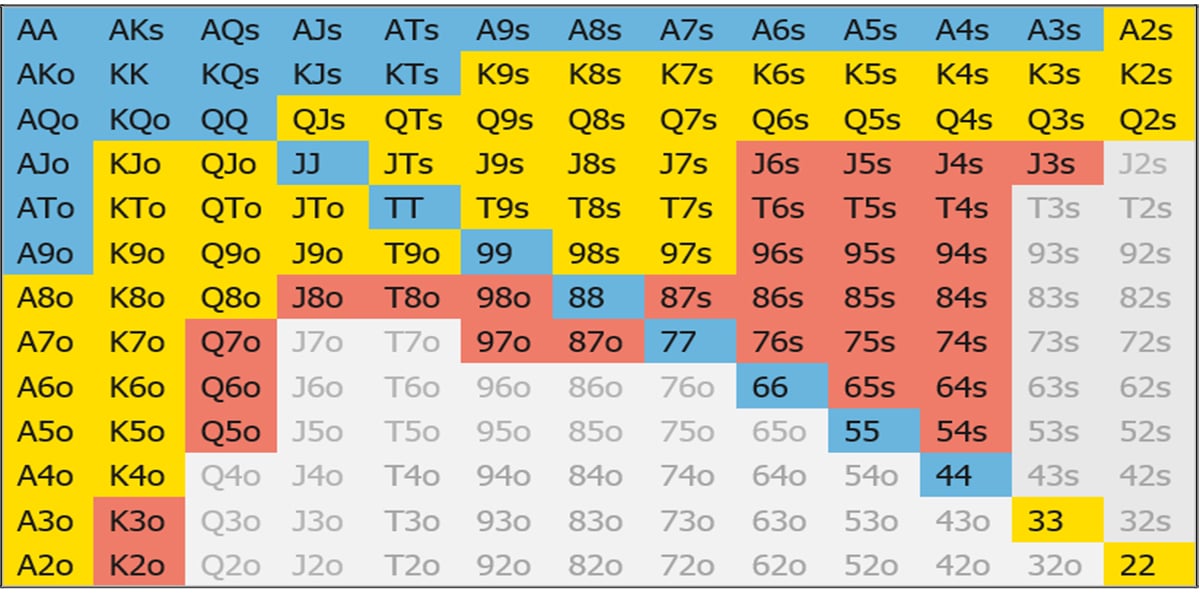Poker Shove Chart
- Poker Heads Up Shove Chart
- Poker Tournament Shove Chart
- Poker Shove Chart
- Poker Shove Charts
- Poker Shove Fold Charts
- This tool has changed the way professionals play poker: 90% of all high stakes players make use of Pio Solver. ICMizer is the best tool when it comes to working out pre-flop ranges for Sit & Gos. Whether you want to know what hands to re-shove or open-shove, this tool will give you the answers. Hand2note, is a great poker tracker software.
- I've tried using both the Power Numbers chart from Kill Everyone, which is based upon 3-8M play far from the money (very rare scenario in a SNG), and also calculators like ICMIZER. Obviously the former doesn't take into account bubble play, table image, player type, etc, and the latter doesn't take into account don't take into table image.
Each chart has three tables; pairs, suited and off-suit which has made it much quicker for me to find my cards on the chart. For the 'Push-Chart when you are first in' chart I have added a field into which I can enter the current big blind and it displays the figures in chips rather than BB multiples.
| Pusher | |||||||||||||
|---|---|---|---|---|---|---|---|---|---|---|---|---|---|
| A | K | Q | J | T | 9 | 8 | 7 | 6 | 5 | 4 | 3 | 2 | |
| A | 20+ | 20+ | 20+ | 20+ | 20+ | 20+ | 20+ | 20+ | 20+ | 20+ | 20+ | 20+ | 20+ |
| K | 20+ | 20+ | 20+ | 20+ | 20+ | 20+ | 20+ | 20+ | 20+ | 20+ | 20+ | 19.9 | 19.3 |
| Q | 20+ | 20+ | 20+ | 20+ | 20+ | 20+ | 20+ | 20+ | 20+ | 20+ | 16.3 | 13.5 | 12.7 |
| J | 20+ | 20+ | 20+ | 20+ | 20+ | 20+ | 20+ | 20+ | 18.6 | 14.7 | 13.5 | 10.6 | 8.5 |
| T | 20+ | 20+ | 20+ | 20+ | 20+ | 20+ | 20+ | 20+ | 20+ | 11.9 | 10.5 | 7.7 | 6.5 |
| 9 | 20+ | 20+ | 20+ | 20+ | 20+ | 20+ | 20+ | 20+ | 20+ | 14.4 | 6.9 | 4.9 | 3.7 |
| 8 | 20+ | 18.0 | 13.0 | 13.3 | 17.5 | 20+ | 20+ | 20+ | 20+ | 18.8 | 10.1 | 2.7 | 2.5 |
| 7 | 20+ | 16.1 | 10.3 | 8.5 | 9.0 | 10.8 | 14.7 | 20+ | 20+ | 20+ | 13.9 | 2.5 | 2.1 |
| 6 | 20+ | 15.1 | 9.6 | 6.5 | 5.7 | 5.2 | 7.0 | 10.7 | 20+ | 20+ | 16.3 | * | 2.0 |
| 5 | 20+ | 14.2 | 8.9 | 6.0 | 4.1 | 3.5 | 3.0 | 2.6 | 2.4 | 20+ | 20+ | ** | 2.0 |
| 4 | 20+ | 13.1 | 7.9 | 5.4 | 3.8 | 2.7 | 2.3 | 2.1 | 2.0 | 2.1 | 20+ | *** | 1.8 |
| 3 | 20+ | 12.2 | 7.5 | 5.0 | 3.4 | 2.5 | 1.9 | 1.8 | 1.7 | 1.8 | 1.6 | 20+ | 1.7 |
| 2 | 20+ | 11.6 | 7.0 | 4.6 | 2.9 | 2.2 | 1.8 | 1.6 | 1.5 | 1.5 | 1.4 | 1.4 | 20+ |
| Caller | |||||||||||||
|---|---|---|---|---|---|---|---|---|---|---|---|---|---|
| A | K | Q | J | T | 9 | 8 | 7 | 6 | 5 | 4 | 3 | 2 | |
| A | 20+ | 20+ | 20+ | 20+ | 20+ | 20+ | 20+ | 20+ | 20+ | 20+ | 20+ | 20+ | 20+ |
| K | 20+ | 20+ | 20+ | 20+ | 20+ | 20+ | 17.6 | 15.2 | 14.3 | 13.2 | 12.1 | 11.4 | 10.7 |
| Q | 20+ | 20+ | 20+ | 20+ | 20+ | 16.1 | 13.0 | 10.5 | 9.9 | 8.9 | 8.4 | 7.8 | 7.2 |
| J | 20+ | 20+ | 19.5 | 20+ | 18.0 | 13.4 | 10.6 | 8.8 | 7.0 | 6.9 | 6.1 | 5.8 | 5.6 |
| T | 20+ | 20+ | 15.3 | 12.7 | 20+ | 11.5 | 9.3 | 7.4 | 6.3 | 5.2 | 5.2 | 4.8 | 4.5 |
| 9 | 20+ | 17.1 | 11.7 | 9.5 | 8.4 | 20+ | 8.2 | 7.0 | 5.8 | 5.0 | 4.3 | 4.1 | 3.9 |
| 8 | 20+ | 13.8 | 9.7 | 7.6 | 6.6 | 6.0 | 20+ | 6.5 | 5.6 | 4.8 | 4.1 | 3.6 | 3.5 |
| 7 | 20+ | 12.4 | 8.0 | 6.4 | 5.5 | 5.0 | 4.7 | 20+ | 5.4 | 4.8 | 4.1 | 3.6 | 3.3 |
| 6 | 20+ | 11.0 | 7.3 | 5.4 | 4.6 | 4.2 | 4.1 | 4.0 | 20+ | 4.9 | 4.3 | 3.8 | 3.3 |
| 5 | 20+ | 10.2 | 6.8 | 5.1 | 4.0 | 3.7 | 3.6 | 3.6 | 3.7 | 20+ | 4.6 | 4.0 | 3.6 |
| 4 | 18.3 | 9.1 | 6.2 | 4.7 | 3.8 | 3.3 | 3.2 | 3.2 | 3.3 | 3.5 | 20+ | 3.8 | 3.4 |
| 3 | 16.6 | 8.7 | 5.9 | 4.5 | 3.6 | 3.1 | 2.9 | 2.9 | 2.9 | 3.1 | 3.0 | 20+ | 3.3 |
| 2 | 15.8 | 8.1 | 5.6 | 4.2 | 3.5 | 3.0 | 2.8 | 2.6 | 2.7 | 2.8 | 2.7 | 2.6 | 15.0 |
| * | 63s: | 7.1 - 5.1, 2.3 |
| ** | 53s: | 12.9 - 3.8, 2.4 |
| *** | 43s: | 10.0 - 4.9, 2.2 |
| Pusher | |||||||||||||
|---|---|---|---|---|---|---|---|---|---|---|---|---|---|
| A | K | Q | J | T | 9 | 8 | 7 | 6 | 5 | 4 | 3 | 2 | |
| A | 20+ | 20+ | 20+ | 20+ | 20+ | 20+ | 20+ | 20+ | 20+ | 20+ | 20+ | 20+ | 20+ |
| K | 20+ | 20+ | 20+ | 20+ | 20+ | 20+ | 20+ | 20+ | 20+ | 20+ | 20+ | 20+ | 20+ |
| Q | 20+ | 20+ | 20+ | 20+ | 20+ | 20+ | 20+ | 20+ | 20+ | 20+ | 18.6 | 15.5 | 14.5 |
| J | 20+ | 20+ | 20+ | 20+ | 20+ | 20+ | 20+ | 20+ | 20+ | 18.5 | 15.4 | 12.4 | 10.3 |
| T | 20+ | 20+ | 20+ | 20+ | 20+ | 20+ | 20+ | 20+ | 20+ | 13.6 | 12.4 | 8.9 | 7.4 |
| 9 | 20+ | 20+ | 20+ | 20+ | 20+ | 20+ | 20+ | 20+ | 20+ | 16.5 | 8.0 | 6.0 | 4.7 |
| 8 | 20+ | 20+ | 14.9 | 15.4 | 20+ | 20+ | 20+ | 20+ | 20+ | 20+ | 11.8 | 3.3 | 3.0 |
| 7 | 20+ | 18.3 | 11.8 | 9.7 | 10.4 | 12.4 | 16.8 | 20+ | 20+ | 20+ | 15.9 | 3.0 | 2.5 |
| 6 | 20+ | 17.4 | 11.3 | 7.5 | 6.7 | 6.5 | 8.5 | 13.5 | 20+ | 20+ | 18.8 | * | 2.4 |
| 5 | 20+ | 16.4 | 10.3 | 7.1 | 4.9 | 4.2 | 3.8 | 3.3 | 3.0 | 20+ | 20+ | ** | 2.4 |
| 4 | 20+ | 15.0 | 9.5 | 6.4 | 4.6 | 3.2 | 2.8 | 2.6 | 2.5 | 2.5 | 20+ | *** | 2.2 |
| 3 | 20+ | 14.3 | 8.6 | 5.8 | 4.2 | 3.0 | 2.3 | 2.2 | 2.1 | 2.1 | 2.0 | 20+ | 2.1 |
| 2 | 20+ | 13.3 | 8.1 | 5.5 | 3.7 | 2.7 | 2.2 | 1.9 | 1.8 | 1.9 | 1.7 | 1.6 | 20+ |
| Caller | |||||||||||||
|---|---|---|---|---|---|---|---|---|---|---|---|---|---|
| A | K | Q | J | T | 9 | 8 | 7 | 6 | 5 | 4 | 3 | 2 | |
| A | 20+ | 20+ | 20+ | 20+ | 20+ | 20+ | 20+ | 20+ | 20+ | 20+ | 20+ | 20+ | 20+ |
| K | 20+ | 20+ | 20+ | 20+ | 20+ | 20+ | 20+ | 17.4 | 16.4 | 15.1 | 13.9 | 12.9 | 12.3 |
| Q | 20+ | 20+ | 20+ | 20+ | 20+ | 18.5 | 14.9 | 12.0 | 11.4 | 10.2 | 9.7 | 8.8 | 8.2 |
| J | 20+ | 20+ | 20+ | 20+ | 20+ | 15.4 | 12.2 | 10.0 | 8.1 | 7.9 | 7.0 | 6.6 | 6.4 |
| T | 20+ | 20+ | 17.8 | 15.1 | 20+ | 13.0 | 10.6 | 8.5 | 7.2 | 6.0 | 5.9 | 5.5 | 5.1 |
| 9 | 20+ | 19.8 | 13.5 | 10.9 | 9.7 | 20+ | 9.5 | 8.0 | 6.7 | 5.6 | 4.8 | 4.6 | 4.3 |
| 8 | 20+ | 16.1 | 11.3 | 8.8 | 7.7 | 6.9 | 20+ | 7.4 | 6.4 | 5.5 | 4.7 | 4.0 | 3.9 |
| 7 | 20+ | 14.3 | 9.2 | 7.4 | 6.5 | 5.7 | 5.4 | 20+ | 6.0 | 5.5 | 4.7 | 4.0 | 3.6 |
| 6 | 20+ | 12.8 | 8.4 | 6.2 | 5.2 | 4.9 | 4.6 | 4.5 | 20+ | 5.5 | 4.7 | 4.2 | 3.7 |
| 5 | 20+ | 11.8 | 7.8 | 5.9 | 4.5 | 4.1 | 4.0 | 4.0 | 4.1 | 20+ | 5.1 | 4.5 | 3.9 |
| 4 | 20+ | 10.5 | 7.1 | 5.4 | 4.3 | 3.7 | 3.5 | 3.6 | 3.7 | 3.8 | 20+ | 4.2 | 3.8 |
| 3 | 19.1 | 9.9 | 6.7 | 5.0 | 4.2 | 3.6 | 3.2 | 3.2 | 3.3 | 3.5 | 3.3 | 20+ | 3.6 |
| 2 | 18.1 | 9.4 | 6.4 | 4.8 | 3.9 | 3.4 | 3.1 | 2.9 | 3.0 | 3.1 | 3.0 | 2.9 | 16.9 |
| * | 63s: | 8.9 - 4.7, 2.8 |
| ** | 53s: | 15.2 - 3.8, 2.9 |
| *** | 43s: | 11.5 - 4.7, 2.6 |
The tables show the highest effective stack size in big blinds where a hand can be pushed or called. Values bigger than 20 are only displayed as 20+, which means the hand can be played for any stack size of 20bb or less. (Playing push-or-fold is typically only recommended up to around 10bb, depending on the situation. Using push-or-fold for >20bb is almost certainly a bad idea.)
Some hands have gaps in their pushing strategies, they are marked with * and the details are displayed below the charts. For example 63s is included in the pushing strategy for stack sizes between 7.1 and 5.1bb, and stacks below 2.3bb.
SB (9.0bb): T3s
BB (6.0bb): Q2o
The effective stack size is the smaller of the two, before posting any blinds. So the relevant stack size for both players in this hand is 6.0 big blinds.
To find the strategy for SB's T3s, check the green area (suited hands) of the 'Pusher' chart. The value for T3s is 7.7bb, and since that is larger than the current effective stacks the hand is a push in the Nash Equilibrium strategy.
To determine if the BB should call with his Q2o, check the orange area (offsuit hands) of the 'Caller' chart and locate Q2o. The value there is 5.6bb. The effective stacks in the current hand are larger than the value for Q2o, so this hand is a fold in the Nash Equilibrium strategy.
This example refers to the no ante solution. If the table values don't match the example then make sure the 'No Ante' tab is selected above.
Poker Heads Up Shove Chart
The solution available on this site was independently calculated and published in 2007 as part of a coding experiment, inspired by the discussion of the topic in Mathematics of Poker.

Similar charts have been published by various sources, including SNGPT and Mathematics of Poker, and there are some minor differences between them. The exact Nash solution is considerably more complex and the chart only shows a simplified version. Most hands are actually played with mixed strategies for at least a few stack sizes, and many hands have multiple smaller gaps in their strategy, similar to the 63s, 53s, 43s hands. These details are omitted in the chart to allow a compact representation of the strategy.
Poker Tournament Shove Chart
The differences in published solutions are most likely due to choices made when simplifying the exact solution into easy-to-use charts. Due to the considerable number of rather arbitrary choices when simplifying into chart form, it is actually quite unlikely that two independently created charts would perfectly match.
The file linked below contains the unsimplified push-or-fold equilibrium strategies for all stacks of 1bb ≤ stacks ≤ 200bb in steps of 0.05bb. This data can be used to derive the charts. For practical purposes the chart form should be completely sufficient though.
The data linked here was re-calculated with a later version than the original chart data, so there may be some very slight differences.


The answer to this is a resounding Yes! We poker players absolutely have a range of hands we should be open-shoving with when short-stacked. In fact, this is one of the few areas of poker that is actually 'solved' by the math geeks of poker. The solution method derives from something called the Nash Equilibrium method.
 In game theory, Nash equilibrium is a method of solving so-called 'non-cooperative games' (like poker) that involve two or more players. Nash assumes that each player is playing perfectly; i.e,. everyone knows the strategies and best decisions of the other players, and no player has anything to gain by changing only their own strategy unilaterally. Said another way: Hero and Villain are in Nash equilibrium if Hero is making the best decision he can, taking into account Villain's strategy, and Villain is making the best decision he can, taking into account Hero's strategy.
In game theory, Nash equilibrium is a method of solving so-called 'non-cooperative games' (like poker) that involve two or more players. Nash assumes that each player is playing perfectly; i.e,. everyone knows the strategies and best decisions of the other players, and no player has anything to gain by changing only their own strategy unilaterally. Said another way: Hero and Villain are in Nash equilibrium if Hero is making the best decision he can, taking into account Villain's strategy, and Villain is making the best decision he can, taking into account Hero's strategy.Uh, okay. What's this got to do short stack poker? Answer: the math boys have used this method to work out the chip-EV calculations for different hand ranges, given an assumed payout structure of an MTT, for different stack sizes and table sizes. The result of this is something called Push-Fold charts. Google/Bing/Yahoo the term and you'll find lots of information on this approach to short stack play. Or, even better, let Uncle Bug do it for you: Just go to a site like Exceptional Poker to get the charts. For instance, here's a chart for open-shoving when you're at 10 big blinds at a full ring table:
If you were in MP with, say four players left to act, and the action folds to you and there are not yet Antes involved, you should be open shoving with: 22+ A7s+ A5s-A3s ATo+ K8s+ KJo+ Q8s+ QJo J8s+ T8s+ 98s. If you have a shorter stack than 10bb, just select the appropriate tab on the web page and go from there. Same with 6-max and heads-up play. (Note that if you have more than 10bb, you should be open-raising to less than all-in.)
Now, are the charts on a site like this perfect for all situations? No, of course not. The charts don't take into account things like individual villain traits and tendencies, and by default they have to assume a specific payout structure that may or may not match the tourney you're playing in (e.g., this particular web site assumes a very top-heavy payout structure). They also assume your opponents are playing perfectly and adjusting accordingly. This is clearly not true...
... but it turns out that this doesn't actually matter much. Most experts agree that if you use correct short-stack push-fold charts like the ones found on Exceptional Poker you will have a significant advantage over ~60% of the players you find at low and mid-stakes online tourneys, and probably a high as 70%+ in your local casino live low-stakes tourneys. Pay attention- this is a really significant edge, folks.
Poker Shove Chart
 Note that if you're new to push-fold Nash charts, you might think the hand ranges seem pretty wide. Well, yes, they are. But the math don't lie, and countless computer simulations by lots of smart poker/math guys have proven that these charts represent the game theory optimal solution and are correct.
Note that if you're new to push-fold Nash charts, you might think the hand ranges seem pretty wide. Well, yes, they are. But the math don't lie, and countless computer simulations by lots of smart poker/math guys have proven that these charts represent the game theory optimal solution and are correct.Note also that the Nash ranges assume you're up against opponents who play perfectly. When they make mistakes or don't play optimally, you profit even more by using the charts. Note however that if your opponent's mistakes are significantly large you can make even more profit by deviating your push/fold ranges from the chart. Usually this means tightening up a wee bit. But don't go too far, or you will be the one straying too far from Nash's recommendations-- and therefore be the one playing sub-optimally.
All-in for now...